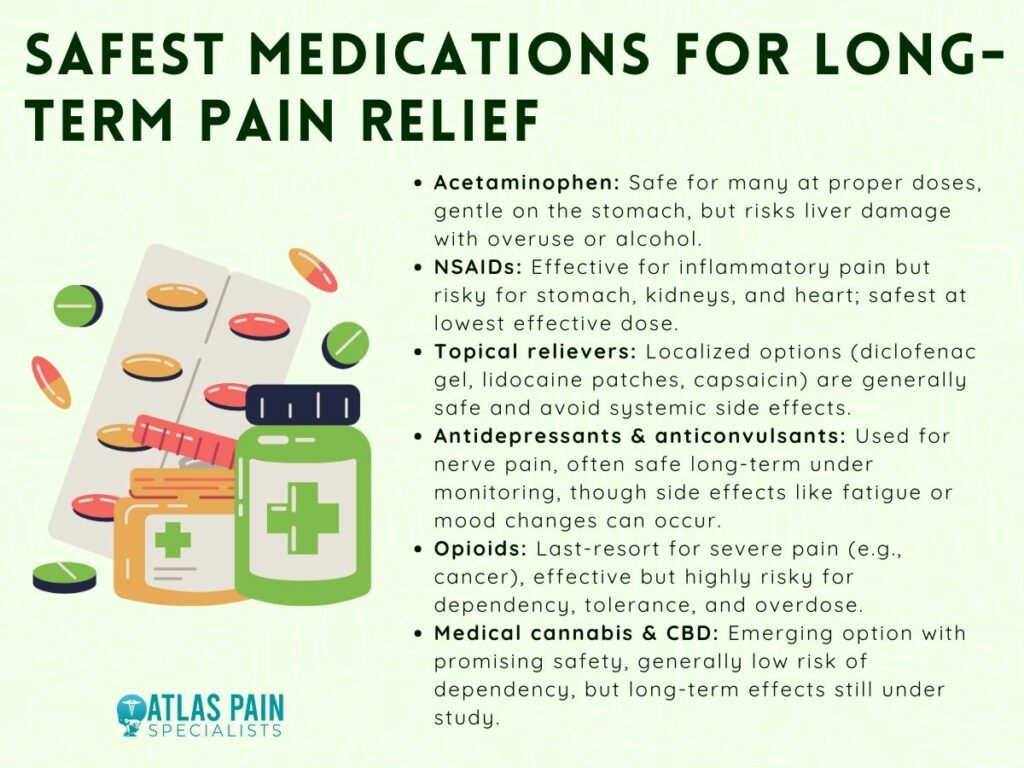

What Is the Safest Pain Medication for Long-Term Use?
Chronic pain is a complex and often frustrating experience, and finding a safe medication to manage it long-term is one of the biggest challenges patients and doctors face. It’s not always about completely eliminating the pain, it’s about making it manageable enough so that daily life can continue with some sense of normalcy. For people living with conditions like osteoarthritis, fibromyalgia, nerve pain, or recurring migraines, the idea of taking medication for years, or even decades, is daunting. The risks, side effects, and effectiveness of each option must be weighed carefully, especially when safety is the priority.
So, the question that often arises is what the safest pain medication for long-term use truly is. There’s no one-size-fits-all answer, but understanding your options can make the decision more informed and personal. What is the safest pain medication for long-term use? Let's find out.

Acetaminophen
Acetaminophen (Tylenol) is often the first suggestion when managing chronic pain, especially for joint or muscle aches.
Acetaminophen is considered one of the safest over-the-counter pain relievers when used at recommended doses, but it has limitations and hidden risks. It works well for mild to moderate pain and doesn’t irritate the stomach like some NSAIDs. People with gastritis or peptic ulcers often prefer it for that reason.
However, it has no anti-inflammatory effect, so for those dealing with inflammation-related conditions, it may not provide full relief. Also, while it’s gentle on the stomach, it can be hard on the liver. Long-term use or high doses, especially when combined with alcohol, increase the risk of liver damage. The FDA recommends not exceeding 4,000 mg per day, but many doctors suggest staying closer to 3,000 mg to be on the safe side.
For individuals with liver issues or those who regularly drink alcohol, acetaminophen may not be the best long-term solution, even though it's generally viewed as safe in the general population.
NSAIDs
Non-steroidal anti-inflammatory drugs (NSAIDs) like ibuprofen (Advil), naproxen (Aleve), and prescription versions such as meloxicam or diclofenac are widely used for chronic pain, especially pain related to inflammation.
While NSAIDs are effective in reducing both pain and inflammation, their long-term use can come with serious side effects involving the stomach, kidneys, and heart. For people with arthritis or musculoskeletal pain, NSAIDs are often more effective than acetaminophen because they address swelling and joint stiffness.
However, chronic NSAID use raises the risk of gastrointestinal bleeding, ulcers, and kidney damage. Seniors and those with high blood pressure or pre-existing kidney conditions are especially vulnerable. There's also an increased risk of cardiovascular events like heart attack or stroke, particularly with long-term use of certain NSAIDs.
To reduce risks, doctors often recommend the lowest effective dose for the shortest duration possible. In some cases, proton pump inhibitors (PPIs) are prescribed alongside NSAIDs to protect the stomach lining.
Still, this class of drugs is a mixed bag. They may be tolerated well by some people for years without complications, while others may develop problems within weeks or months.
Topical Pain Relievers
Not all pain medications are taken orally. In fact, some of the safest pain treatments for long-term use are applied directly to the skin.
Topical medications like diclofenac gel, lidocaine patches, and capsaicin cream offer localized relief without exposing the whole body to systemic side effects. This makes them an appealing option for people with chronic pain in specific joints or areas, such as knees, shoulders, or lower back.
Diclofenac gel, for example, is an NSAID but applied topically, which significantly reduces the risk of stomach issues and kidney problems. It’s commonly prescribed for osteoarthritis. Lidocaine patches numb the area temporarily and are useful for nerve pain, especially post-shingles or diabetic neuropathy. Capsaicin cream, made from chili peppers, gradually reduces pain signal transmission when used regularly.
While these aren’t ideal for deep, widespread pain, they are generally safe and can be used alongside oral medications for a more comprehensive plan.
Antidepressants and Anticonvulsants for Nerve Pain
Chronic pain isn’t always caused by tissue damage. Nerve-related pain, or neuropathic pain, requires a different approach altogether.
Medications originally developed for depression or seizures are now frontline treatments for chronic nerve pain, and many are considered safe for long-term use when monitored. These include drugs like amitriptyline, nortriptyline, duloxetine (Cymbalta), and gabapentin or pregabalin (Lyrica).
Duloxetine is FDA-approved for conditions like fibromyalgia and chronic musculoskeletal pain. Gabapentin and pregabalin are widely prescribed for diabetic nerve pain, sciatica, and other nerve conditions. These medications don’t carry the same liver or kidney risks as NSAIDs, but they do come with their own considerations.
Fatigue, dizziness, and mood changes are common early side effects, and some people may experience weight gain or brain fog. For those with mental health concerns, these drugs may actually help improve mood and sleep, making them a two-in-one treatment. However, for others, side effects can outweigh the benefits.
These medications typically require careful dose titration and ongoing check-ins, but for many, they offer long-term relief with relatively low physical risk.
Opioids
For severe chronic pain, such as that caused by cancer, serious injury, or multiple failed surgeries, opioids may be part of the conversation. But long-term use brings many red flags.
While opioids are powerful pain relievers, they carry the highest risk of dependence, tolerance, and overdose, making them a last resort for long-term pain treatment. Drugs like oxycodone, hydrocodone, morphine, and fentanyl can provide much-needed relief in situations where other medications fail, but their long-term safety profile is deeply problematic.
Even at stable doses, opioids can cause constipation, hormone imbalance, depression, and increased sensitivity to pain over time (a condition called opioid-induced hyperalgesia). Tolerance often means that people need higher and higher doses to achieve the same effect, which increases overdose risk.
Some patients, under careful pain management programs, may use opioids safely for years. These are often cancer patients or individuals in hospice care. For others, especially younger individuals with non-terminal conditions, the risks usually outweigh the rewards.
In recent years, the medical community has become more cautious about prescribing opioids, and they are rarely recommended as a first or even second-line treatment for chronic pain.
Medical Cannabis and CBD
With growing legalization, more people are turning to cannabis-based products for pain relief.
CBD and medical cannabis offer an alternative for some chronic pain sufferers, but long-term safety data is still emerging. Cannabidiol (CBD), a non-psychoactive component of cannabis, has shown promise for treating inflammation, nerve pain, and even arthritis discomfort.
Unlike opioids, CBD does not cause dependence and is generally well-tolerated. Side effects are usually mild and may include drowsiness, diarrhea, or changes in appetite. Medical marijuana (THC-containing products) is stronger but can impair memory, coordination, and motivation over time. It may also carry a risk of dependency with frequent use.
For people seeking alternatives to prescription drugs, cannabis-based therapies are worth exploring with a doctor’s guidance. However, legal access, standardization, and cost remain challenges across many states.
Non-Drug Approaches That Support Long-Term Relief
Sometimes, the safest “medication” isn’t medication at all. For long-term pain sufferers, combining pharmaceutical and non-pharmaceutical methods often delivers the most sustainable results.
Exercise, physical therapy, mindfulness, and cognitive behavioral therapy (CBT) are all evidence-based tools that can reduce pain perception and improve quality of life without the side effects of drugs. In fact, the CDC recommends non-drug approaches as first-line treatments for many types of chronic pain.
Low-impact exercises like walking, swimming, and yoga build strength and flexibility, reducing strain on painful joints. CBT helps patients reframe how they experience pain and build coping skills. Mindfulness and meditation can lower stress, which directly influences pain intensity.
Integrating these methods doesn't mean you have to quit medications altogether. But when used together, they may reduce the need for higher drug doses and lower the risk of long-term complications.
Which Pain Medications Are Safe for Specific Conditions?
Different pain conditions call for different treatments, and safety varies based on what you're dealing with. Here's a general overview:
| Condition | Generally Safer Long-Term Options | Caution/High-Risk Options |
| Osteoarthritis | Acetaminophen, topical NSAIDs, duloxetine | Oral NSAIDs, opioids |
| Neuropathy (Nerve Pain) | Gabapentin, pregabalin, amitriptyline | Opioids, long-term NSAIDs |
| Chronic Back Pain | Physical therapy, NSAIDs (short-term), duloxetine | Opioids, muscle relaxants |
| Fibromyalgia | Duloxetine, milnacipran, low-dose amitriptyline | Opioids, high-dose NSAIDs |
| Migraines | Topiramate, propranolol, tricyclics | Daily NSAID use, opioids |
| Cancer Pain | Opioids under supervision | High-dose NSAIDs (due to organ damage) |
This table is a helpful guide, but it's not a substitute for individual evaluation by a healthcare provider. The safest option for one person might not be safe for another, depending on age, medical history, and other medications.
So, What Is the Safest Pain Medication for Long-Term Use?
Ultimately, the safest pain medication for long-term use depends on the cause of your pain, your overall health, and how your body responds to different treatments.
For most people, medications like acetaminophen, certain antidepressants, topical NSAIDs, and low-dose nerve pain drugs offer the best balance between safety and effectiveness. But there’s no universal winner. It's about finding a regimen that works for your body without compromising your health over time.
This is why pain management often involves trial and error, regular follow-up, and a multidisciplinary approach. The goal isn’t just to dull the pain, but to maintain function, improve mood, and preserve quality of life.
Conclusion
Pain that lingers for months or years changes everything, from how you sleep and move to how you think and feel. That’s why choosing the right long-term pain management plan is a decision that should involve both personal reflection and professional guidance.
While some medications are more tolerated over time than others, there is no magic pill. The safest approach to long-term pain relief is often a thoughtful combination of low-risk medications, non-drug therapies, and regular check-ins with your healthcare team. Whether you're managing arthritis, nerve pain, or something more complex, safety should never take a back seat to quick fixes.
Understanding your body’s needs and staying open to adjustments along the way is the real key to sustainable relief.
About Dr. Sean Ormond



